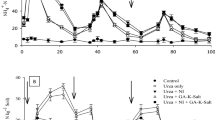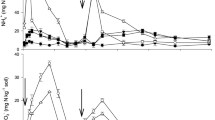Abstract
We studied the interacting effects on NH3 loss and grain yield of adding (1) urease inhibitors to retard the hydrolysis of urea (2) the algicide terbutryn to limit floodwater pH increases, and (3) C2H2 (provided by waxcoated calcium carbide) to prevent NH3 oxidation. The algicide treatment maintained the floodwater pH values below 8 for the first 3 days after the urea application and depressed the maximum values below 8.5 on subsequent days. As a consequence, NH3 loss was significantly (P<0.05) reduced in all treatments containing algicide. The addition of wax-coated calcium carbide effectively inhibited nitrification, as judged by the increased ammoniacal (NH3+NH4) N concentrations in the floodwater, However, these increased ammonical-N concentrations resulted in large losses of NH3. The results also showed that the effectiveness of a urease inhibitor cannot be judged solely from the ammonical-N concentrations in the floodwater of a single treatment with the inhibitor. Additional treatments with an algicide and a nitrification inhibitor are required to determine whether the low ammoniacal-N concentrations are caused by NH3 losses and nitrification. Thus N-(n-butyl)thiophosphorictriamide (NBPT) appeared to retard urea hydrolysis when judged by the low ammoniacal-N concentrations in the floodwater; however, treatments with NBPT, algicide, and C2H2 showed that the low concentrations were mainly a result of NH3 volatilization and nitrification. Even though NBPT did not completely inhibit urea hydrolysis, some treatments with this compound reduced NH3 losses and increased grain yields by up to 31%.
Similar content being viewed by others
References
Austin ER, Bradford TJ, Lupin M (1984) High performance liquid chromatographic determination and hydrolysis studies of phenyl phosphorodiamidate, a urease inhibitor. J Agric Food Chem 32:1090–1096
Banerjee NK, Mosier AR (1989) Coated calcium carbide as a nitrification inhibitor in upland and flooded soils. J Indian Soc Soil Sci 37:306–313
Bowmer KH, Muirhead WA (1987) Inhibition of algal photosynthesis to control pH and reduce ammonia volatilization from rice flood-water. Fert Res 13:13–29
Bronson KF, Mosier AR (1991) Effect of encapsulated calcium carbide on dinitrogen, nitrous oxide, methane, and carbon dioxide emissions from flooded rice. Biol Fertil Soils 11:116–120
Buresh RJ, De Datta SK (1990) Denitrification losses from puddled rice soils in the tropics. Biol Fertil Soils 9:1–13
Buresh RJ, De Datta SK, Padilla JL, Chua TT (1988a) Potential of inhibitors for increasing response of lowland rice to urea fertilization. Agron J 80:947–952
Buresh RJ, De Datta SK, Padilla JL, Samson MI (1988b) Field evaluation of two urease inhibitors with transplanted lowland rice. Agron J 80:763–768
Cai GX, Zhu ZL, Trevitt ACF, Freney JR, Simpson JR (1986) Nitrogen loss from ammonium bicarbonate and urea fertilizers applied to flooded rice. Fert Res 10:203–215
Cai GX, Freney JR, Muirhead WA, Simpson JR, Chen DL, Trevitt ACF (1989) The evaluation of urease inhibitors to improve the efficiency of urea as a N-source for flooded rice. Soil Biol Biochem 21:137–145
Chai HS, Bremner JM (1987) Evaluation of some phosphoroamides as soil urease inhibitors. Biol Fertil Soils 3:189–194
Chai HS, Bremner JM, McCarty GW (1988) Effect of N-(n-butyl)thiophosphoric triamide on hydrolysis of urea by plant, microbial and soil ureases. Agron Abs 213
Creason GL, Schmitt MR, Douglas SEA, Hendrickson LL (1990) Urease inhibitory activity associated with N-(n-butyl)thiophosphoric triamide is due to formation of its oxon analogue. Soil Biol Biochem 22:209–211
De Datta SK, Buresh RJ (1989) Integrated nitrogen management in irrigated rice. Adv Soil Sci 10:143–169
De Datta SK, Trevitt ACF, Freney JR, Obcemea WN, Real JG, Simpson JR (1989) Measuring nitrogen losses from lowland rice using bulk aerodynamic and nitrogen-15 balance methods. Soil Sci Soc Am J 53:1275–1281
Denmead OT (1983) Micrometeorological methods for measuring gaseous losses of nitrogen in the field. In: Freney JR, Simpson JR (eds) Gaseous loss of nitrogen from plant-soil systems. Martinus Nijhoff/Dr W Junk Publishers, The Hague, pp 133–157
Fillery IRP, De Datta SK (1986) Ammonia volatilization from nitrogen sources applied to rice fields: 1. Methodology, ammonia fluxes, and nitrogen-15 loss. Soil Sci Soc Am J 50:80–86
Fillery IRP, Vlek PLG (1986) Reappraisal of the significance of ammonia volatilization as an N loss mechanism in flooded rice fields. Fert Res 9:79–98
Fillery IRP, Simpson JR, De Datta SK (1984) Influence of field environment and fertilizer management on ammonia loss from flooded soil. Soil Sci Soc Am J 48:914–920
Fillery IRP, Simpson JR, De Datta SK (1986) Contribution of ammonia volatilization to total nitrogen loss after application of urea to wetland rice fields. Fert Res 8:193–202
Freney JR, Trevitt ACF, Muirhead WA, Denmead OT, Simpson JR, Obcemea WN (1988) Effect of water-depth on ammonia loss from lowland rice. Fert Res 16:97–107
Freney JR, Trevitt ACF, De Datta SK, Obcemea WN, Real JG (1990) The interdependence of ammonia volatilization and denitrification as nitrogen loss processes in flooded rice in the Phillippines. Biol Fertil Soils 9:31–36
Keerthisinghe DG, Freney JR, Mosier AR (1993) Effect of waxcoated calcium carbide and nitrapyrin on nitrogen loss and methane emission from dry-seeded flooded rice. Biol Fertil Soils 16:71–75
Leuning R, Freney JR, Denmead OT, Simpson JR (1985) A sampler for measuring atmospheric ammonia flux. Atmos Environ 18:1583–1592
Luo Qui-xiang, Freney JR, Keerthisinghe DG, Peoples MB (1994) Inhibition of urease activity in flooded soils by phenylphosphorodiamidate and N-(n-butyl)thiophosphorictriamide. Soil Biol Biochem 26:1059–1065
Martens DA, Bremner JM (1984) Effectiveness of phosphoroamides for retardation of urea hydrolysis in soils. Soil Sci Soc Am J 48:302–305
McCarty GW, Bremner JM, Chai HS (1989) Effect of N-(n-butyl)thiophosphoric triamide on hydrolysis of urea by plant, microbial, and soil urease. Biol Fertil Soils 8:123–127
Mikkelsen DS, De Datta SK, Obcemea WN (1978) Ammonia volatilization losses from flooded rice soils. Soil Sci Soc Am J 42:725–730
Mobley HLT Hausinger RP (1989) Microbial ureases: significance, regulation and molecular characterization. Microbiol Rev 53:85–108
Mosier AR, Chapman SL, Freney JR (1989) Determination of dinitrogen emission and retention in floodwater and porewater of a lowland rice field fertilized with 15N-urea. Fert Res 19:127–136
Mulvaney RL, Bremner JM (1979) A modified diacetylmonoxime method for colorimetric determination of urea in soil extracts. Commun Soil Sci Plant Anal 10:1163–1170
Orion (1983) Instruction manual for ammonia electrode model 95–12. Orion Research Inc, Cambridge, Mass
Phongpan S, Byrnes BH (1990) The effect of the urease inhibitor N-(n-butyl) thiophosphoric triamide on the efficiency of urea application in a flooded rice field trial in Thailand. Fert Res 25:145–151
Pugh KB, Waid JS (1969a) The influence of hydroxamates on ammonia loss from an acid loamy sand treated with urea. Soil Biol Biochem 1:195–206
Pugh KB, Waid JS (1969b) The influence of hydroxamates on ammonia loss from various soils treated with urea. Soil Biol Biochem 1:207–217
Rodgers GA (1983) Effect of dicyandiamide on ammonia volatilization from urea in soil. Fert Res 4:361–367
Simpson JR, Freney JR (1988) Interacting processes in gaseous nitrogen loss from urea applied to flooded rice fields. In: Pushparajah E, Husin A, Bachik AT (eds) Int Symp on Urea Technology and Utilization. Malaysian Society of Soil Science, Kuala Lumpur, pp 281–290
Simpson JR, Freney JR, Muirhead WA Leuning R (1985) Effects of phenylphosphorodiamidate and dicyandiamide on nitrogen loss from flooded rice. Soil Sci Soc Am J 49:1426–1431
United States Department of Agriculture (1983) Keys to Soil Taxonomy. Soil Management Support Services, USDA, Tech Monogr 6, US Government Printing Office, Washington
Vlek PLG, Craswell ET (1981) Ammonia volatilization from flooded soils. Fert Res 2:227–245
Zhu ZL (1992) Efficient management of nitrogen fertilizers for flooded rice in relation to nitrogen transformations in flooded soils. Pedosphere 2:97–114
Zhu ZL, Chen RY, Xu YH (1979) The effect of forms and methods of placement of fertilizers on the characteristics of the nitrogen supply in paddy soils. Acta Pedol Sin 16:218–233
Author information
Authors and Affiliations
Rights and permissions
About this article
Cite this article
Chaiwanakupt, P., Freney, J.R., Keerthisinghe, D.G. et al. Use of urease, algal inhibitors, and nitrification inhibitors to reduce nitrogen loss and increase the grain yield of flooded rice (Oryza sativa L.). Biol Fert Soils 22, 89–95 (1996). https://doi.org/10.1007/BF00384438
Received:
Issue Date:
DOI: https://doi.org/10.1007/BF00384438




